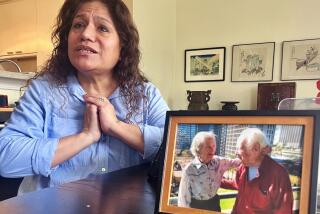Study of Twins Aims to Probe Mysteries of Alzheimer’s
- Share via
All of her life, Ilene Eddy has been able to look at her sister, Irene Peterson, and see a mirror image of herself.
The twins, as everyone still calls them, have always dressed alike, worn their hair the same and done things together. Back on the farm in Iowa, where they grew up in a family of 10 children, it was said that if you stepped on one’s toes, the other one felt it.
Even today, the sisters, both widowed, dress alike and live together in a Long Beach duplex.
But at 87, Ilene sees not only her mirror image when she looks at her white-haired identical twin; she also sees her disturbing future.
“For 19-year-olds we’re in good health,” Ilene joked during a break in their monthly samba card game in a golf course clubhouse. Then, with a nod to Irene, she added, “My health is a little better than hers.”
It’s about as close as Ilene gets to confirming what is clear to friends and relatives: She and her twin have Alzheimer’s disease.
More than 4 million Americans are afflicted with the progressive and irreversible disease that attacks the brain and results in impaired memory, thinking and behavior.
Despite the fact that new studies continue to suggest genetic clues, the precise cause of Alzheimer’s disease remains a mystery. For reasons that continue to perplex researchers, the disease progresses at different rates with each individual--even twins with identical genes. Researchers know that when an identical twin gets Alzheimer’s, there is about a 50% chance--regardless of age--that the other will also have or develop it.
The sisters recently became part of an ongoing national study by Duke University of 65 identical twin pairs of all ages in which one or both twin members have the disease.
The purpose of the study is to identify environmental, medical or lifestyle causes of the disease, said Brenda Plassman, one of the investigators in Durham, N.C.
Irene showed signs of Alzheimer’s six years ago, when relatives discovered her having a conversation with her “twin” in a mirror. She is now in an advanced stage of the disease.
Ilene is in an early stage of Alzheimer’s; friends and relatives noticed she was having problems with short-term memory about two years ago.
Irene can no longer be left alone or hold a normal conversation; Ilene is able to do most things for herself but often repeats statements and doesn’t know her way home. A part-time health aide helps out during the day.
Memories of the old days, when their mother dressed them in matching outfits and they rode a horse-drawn buggy to a country school, are in easy reach for Ilene. But, as is typical in the early stages of Alzheimer’s, details of the recent past are much harder to grasp.
For her sister, past and present are a blur.
This is frustrating to researchers who are seeking clues about the differences in twins’ lives to explain why different levels of Alzheimer’s have set in. Factors like occupation, medical history, medications and exposure to toxic substances such as pesticides and solvents require specific recollections.
*
By combining Ilene’s stories with information from friends and relatives, the twins’ stories emerge.
Although their paths diverged in Iowa in the early 1940s and intersected again in Southern California later that decade, Ilene and Irene have led remarkably parallel lives. And, according to their nephew, Larry Lindgren of Camarillo, the twins have always enjoyed good health.
Born on Jan. 30, 1911, they grew up with eight brothers and sisters on their family’s 160-acre farm in western Iowa, about 100 miles southeast of Sioux City.
“Our place was one of the few ones that was modern,” Ilene said. They had electricity supplied by batteries in the basement of their big, two-story farmhouse. A farm with electricity was so unusual in the area at the time, she recalled, that the local newspaper came out and took a picture.
The twins didn’t go to college, their nephew said, and both began working while still in high school.
“They originally sold cosmetics for a woman called Dr. Namour,” Lindgren said. When Namour moved, the twins started their own small cosmetics manufacturing company, selling products throughout the Midwest.
Lindgren, 71, remembers that “as a youngster what impressed me when they were touring around in this cosmetics business is they had somehow acquired a big Cadillac with big wood-spoke wheels and a V-8 engine. It was really a fancy bus.”
After a few years, he said, “they decided that traveling wasn’t the way to go,” and they opened a beauty shop in Sioux City.
In the mid-1930s, Irene married dairy farmer Roy Peterson. The couple moved to Bellflower about 1944 and Roy got a job as a pipe fitter for Shell Oil. Irene sold household products through parties in customers’ homes.
*
Ilene ended up in a Civil Service job as a secretary--first in Utah, then in Hawaii and Guam during the war. After the war, she got a secretarial job at the VA Hospital in Long Beach. In the mid-1950s she married Elmer Eddy, a retired Episcopal minister who had once preached on the radio in Boston.
In the mid-1950s, Ilene and Irene set up their households within five blocks of each other in Seal Beach. Neither had children. Elmer Eddy died in 1970, Roy Peterson in 1971.
Not long after the deaths, the twins bought their duplex in Long Beach--Irene living on one side, Ilene in the other.
That’s how Gus Modaffari, 65, a Seal Beach real estate broker who eventually became the twins’ property manager, met them.
Despite the sisters’ close physical resemblance, Modaffari recalls personality and lifestyle differences between the two.
“Irene was the strongest, more masculine, more forward,” he said. “She smoked with me a long time. She drank with me. Irene liked straight whiskey, whereas Ilene liked mixed drinks. We’re talking, like, one--if you were lucky.”
In July, a nurse and neuropsychological technician from Duke visited Ilene and Irene to review their medical histories and conduct a physical examination and neuropsychological testing for memory, language and complex thinking.
Studies have reported that head trauma and fewer years of education may be potential risk factors for Alzheimer’s. Yet Duke researcher Plassman emphasizes that “virtually no potential nongenetic risk factor except age has been shown to hold up in all studies.”
Nephew Lindgren said changes in the sisters’ behavior forced him to make changes in 1994. He moved Irene into Ilene’s half of the two-story Long Beach duplex the sisters had shared since the mid-1970s. And he hired a part-time home health aide to help care for Irene.
In early 1996, Lindgren enrolled the sisters in an adult day-care program at the John Douglas French Center for Alzheimer’s Disease in Los Alamitos. But soon Lindgren and property manager Modaffari made a troubling discovery: Ilene, like many elderly Americans, was being scammed by questionable charity solicitors.
“One guy had, like, nine charities, and he just kept working them for larger and larger amounts,” Lindgren says.
Modaffari said: “They were taken to the cleaners. Charities would come in and tell them, ‘We’d like you to give,’ and Ilene--oh, she’s a peach of a person--would give them a check. She’d write checks for small amounts, and they’d change the amounts.”
*
When the twins’ bank notified Modaffari that a $17.50 check Ilene had written had been altered to read $1,750, he says, “we stopped their account immediately.”
Lindgren and Modaffari agreed something had to be done to protect the women.
In May 1996, a conservatorship was established for Ilene and Irene, with Modaffari the court-appointed conservator of the twins’ estate and Lindgren conservator of their person.
Although Ilene continued to attend the day program at the French Center, Irene’s attendance was sporadic; she had difficulty following directions. By the end of 1996, only Ilene attended.
Last January, the family got together to celebrate the twins’ 87th birthday.
Lindgren and his wife, Janet, his aunt Edna Mae and her daughter, Joann, took the twins out to dinner before a party at Edna Mae’s 1950s-vintage tract home in Bellflower.
“We had a good dinner,” Ilene said, climbing out of the car and joking that “we’re celebrating our 21st birthday, so we can vote now.”
Someone asked Ilene if she remembered having birthday parties as a child.
“There were 10 children in the family,” she said, “but that was my mother’s big day, so we always had birthday parties. She always had a birthday cake, and in those days they didn’t buy the cakes.”
Irene, as is her habit since Alzheimer’s began its irreversible assault on her brain, began whistling. Ilene, caught up in the festive spirit of their 87th birthday, happily continued.
“Really,” she said, “we were raised on a farm back in Iowa, and we had a lot of fun and enjoyed life. And we got along good. We had a happy childhood.”
Before Ilene and Irene opened their presents, Janet Lindgren mentioned that Irene is the older of the twins. Was it by two minutes? she asks Ilene.
Ilene responded with a joke she undoubtedly had told many times, but one that was now weighted with irony.
“I was there,” she said with a grin, “but I don’t remember.”
(BEGIN TEXT OF INFOBOX / INFOGRAPHIC)
Fading Away
Alzheimer’s is a degenerative brain disease and is the most common type of dementia-causing illness. Its cause is unknown; there is no cure.
Facts About Disease
Approximately 4 million Americans have Alzheimer’s disease.
14 million Americans will have Alzheimer’s by the middle of the next century unless a cur or prevention is found.
Alzheimer’s disease is the fourth leading cause of death among adults, taking more than 100,000 lives each year.
The disease affects primarily people over 65 but can strike people in their 49s and 50s. One in 10 people over 65 and nearly half of those over 85 have Alzheimer’s disease.
A person with Alzheimer’s disease can live from three to 20 years or more after the onset of symptoms.
Alzheimer’s disease costs society approximately $100 billion a year. Neither Medicare nor private health insurance covers the type of care most patients need, so most of his this cost is borne by their families.
The cost of paid home care averages $18,000 annually.
State of Research
More than 50 drugs are being studied for the possible treatment of Alzheimer’s disease, but only two have been approved by the Food and Drug Administration: tacrine and donepezil. Both delay the course of the disease in some people, but neither halts the progression. Estrogen therapy, gingko biloba and non-steroidal anti-inflammatory drugs such as the ibuprofen, naproxen and indomethacin are thought to delay its onset. Researchers are not sure what causes Alzheimer’s, but it is clear that genetics play an important role. At least three different genes have been shown to increase susceptibility to the disease.
*
The cavum septum pellucidum is the butterfly shape in the center of the brain. This area is affected by Alzheimer’s disease, which kills cells there. The area atrophies, causing confusion, memory loss, and personality and behavior changes.
Source: Southwest for Clinical Research, Alzheimer’s Disease and Related Disorders Assn. Inc.






